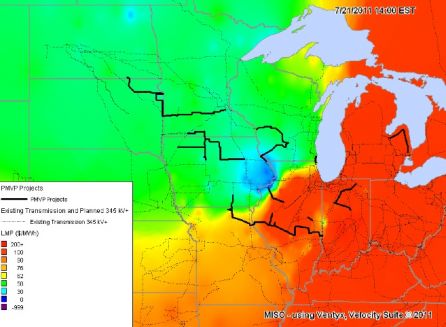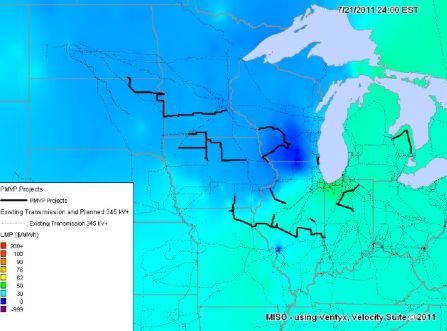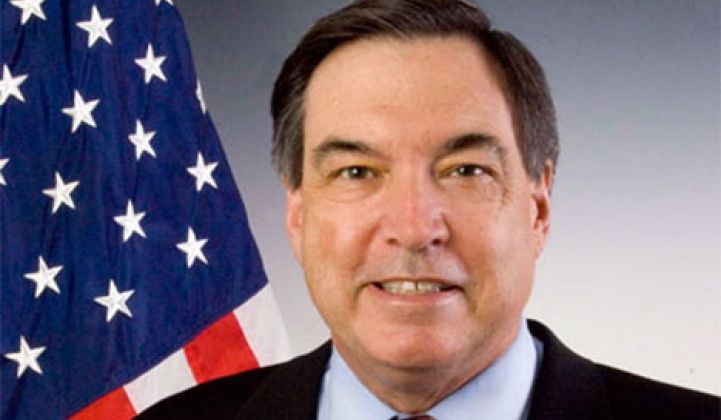As we reported yesterday, Jon Wellinghoff, chairman of the Federal Energy Regulatory Commission, is resigning his post after a four-year tenure marked by some formative support for renewable energy, energy storage, demand response and smart grid technologies. Politico reported Wednesday that potential nominees include Arkansas Public Service Commission Chairwoman Colette Honorable and current FERC Commissioner John Norris, the next most senior Democrat on the commission.
Wellinghoff made a presentation in 2012 that was notable for its vision of more rational energy pricing markets and its practical graphics. We revisit it here.
"A Day in the Life of the Grid" revealed that the FERC commissioners get the smart grid and the necessity "to unleash the information and unleash the power" of the American electrical grid, as Wellinghoff put it. His presentation gave an hour-by-hour snapshot of wholesale utility pricing across the Midwest Independent System Operator (MISO) using diagrams based on Ventyx imaging software. (Ventyx was acquired by ABB for over $1 billion in May of 2010.)
Wellinghoff spoke of the need for utilities to be "restructured to unbundle their service" and to "think in non-traditional terms, where utilities are a different animal."
"Unleashing information on energy and prices allows consumers to use their energy smartly," according to the Commissioner, and "the first step is to give consumers access to the real costs of delivered energy -- so that they're not in the dark."
Wellinghoff noted that it's becoming increasingly affordable to control the timing and duration of energy use given the advances in hardware, software and regulatory sophistication.
"Coupling energy consumption with real-time pricing...is a very powerful tool," said the now-retiring Commissioner.
Here's the gist of his presentation, now with images that were not available in the original article. The full FERC PDF file is here.
A Day in the Life of the Grid
July 21, 2011 is a day that will live in infamy.
Not really. But it was the hottest day of the year in the Midwest, and the Midwest Independent System Operator (MISO) territory, which spans 13 states, has 140,000 megawatts of generation under its control, and sells $27 billion of electricity per year.
And on this particular day in July, the region would experience a new peak of 104 gigawatts.
Wellinghoff gave an hour-by-hour status of the MISO region. He looked at the impact on big-box stores, aluminum smelters, data centers, and electric-vehicle charging. He noted that consumers are paying $0.09 per kilowatt-hour despite the wholesale rate ranging from $0.00 to $1.00 per kilowatt-hour.
2:00 a.m.: Despite low energy prices across the region, there is no rate incentive for consumers to charge their electric vehicles at this time of day. Electric vehicles could provide regulation service -- if they could participate in the market, according to Wellinghoff.
3:00 a.m.: Prices are near zero.

4:00 a.m.: Wind resources are still trapped in the western portion of the region because of transmission issues. The average wholesale energy price is about $0.023 cents per kilowatt-hour. At this time, an EV could charge at 40 cents per gallon gasoline equivalent, according to Wellinghoff.
5:00 a.m.: People in Detroit are waking up, and as power ramps up, pricing starts to rise.
7:00 a.m.: Wind starts to ramp.
8:00 a.m.: Trapped wind prices rise in constrained areas, but 100 miles away, prices are 10 cents per kilowatt-hour. The grid has generators inefficiently ramping up when it would be more efficient for customers to change their loads. Wellinghoff said that this is an inefficient way of operating the grid.
9:00 a.m.: MISO declares a maximum energy event.

9:35 a.m.: Frequency on some lines drops to 59.964 cycles.
10:00 a.m.: Wind "is falling off a cliff" but ramp is rising. Peak wind is 3 gigawatts less than the previous day.
11:00 a.m.: High prices above $0.10 per kilowatt-hour start to hit the system as imports from PJM dry up.
12:00 p.m.: The wholesale markets are indicating the true costs of energy, but there is a disparity between the wholesale price and the price the customer is paying.
1:00 p.m.: The temperature is 100 degrees, but wind is down to 1 gigawatt. Only 1,800 of 30,000 turbines are producing power.
2:00 p.m.: Maximum energy warning declared.

4:00 p.m.: PJM sets an all-time peak record of 160 gigawatts while wind drops to a low point. There is a west-to-east price shift that shows a need for transmission build-out.
5:00 p.m.: The maximum energy event is terminated, but people are still making energy decisions with no knowledge of real-time electricity pricing.
6:00 p.m.: Temperatures are starting to cool off in the Midwest and prices have halved.
7:00 p.m.: Higher temperatures are holding firm in some areas and keeping the supply-demand balance tight.
8:00 p.m.: The heat index near the Lake Michigan shoreline and in eastern Michigan drops and demand falls.
9:00 p.m.: Streetlights come on and generating resources go down. MISO brings on more expensive power.

12:00 a.m.: The system becomes unconstrained as the load continues to drop.

The FERC Commissioner summed up his talk with this statement:
"If we want our nation's energy system to remain efficient, we need to align prices with the costs of production. With a new transparent pricing environment, an array of businesses and aggregators can provide automated services that will control consumer loads. In sum, the new opportunity in energy is to align the [consumer] price with the real wholesale price."
He added that this will "enable loads like water heaters, refrigerators, and EVs to adapt to pricing. This is the challenge for the entire smart grid and cleantech industry."
He exhorted those in the utility industry to "unleash the information [and] unleash the power."



